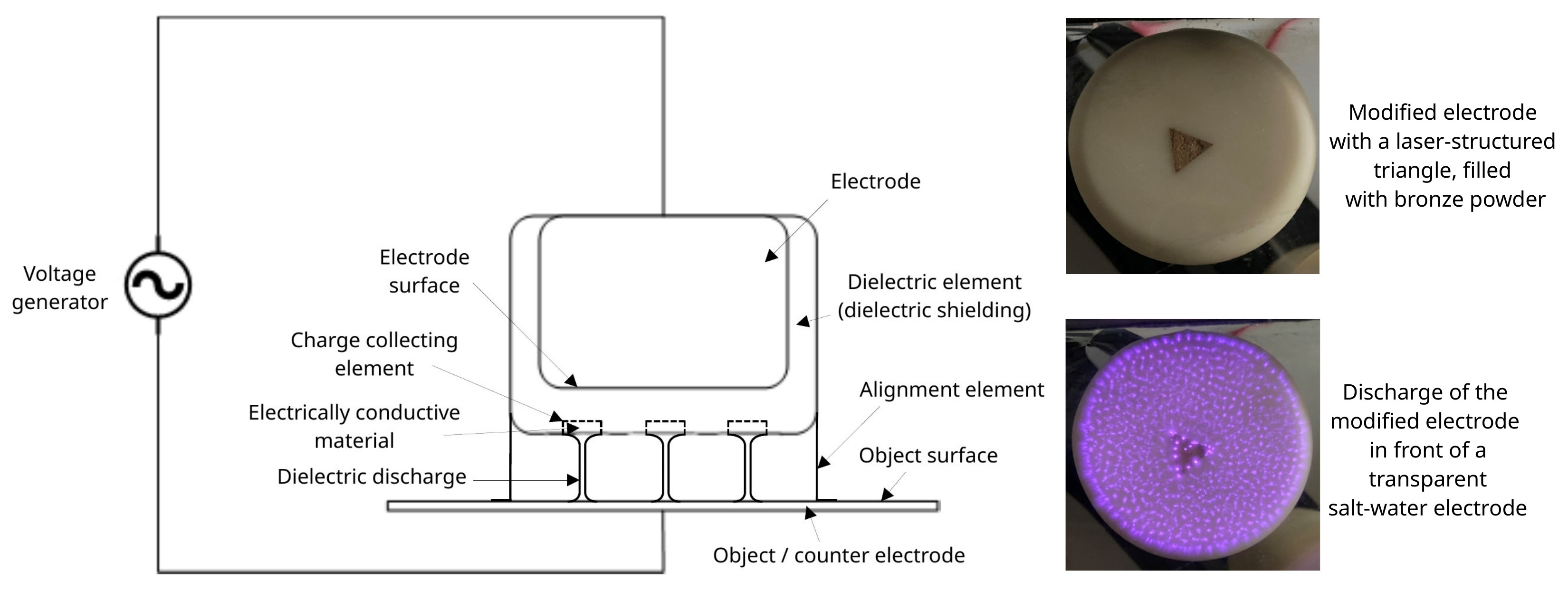
Plasma electrodes for pulse energy enhancement
A technology for the generation of a non-thermal plasma with enhanced pulse energy is presented. Electrodes are tailored with charge collecting elements, which trigger enhanced pulse energies in plasma filaments and a targeted formation of filamented discharges.
Challenge
Research and development activities show, that dielectric barrier discharge (DBD) cold plasmas can be useful in surface treatment processes, disinfection of wounds, sterilization of seeds and air cleaning. Cold plasmas can be generated by electrical discharge between two electrodes separated by an insulating (dielectric) material. Electrode surface condition, electrode distance, gas parameters and the amplitude and slew rate of high-voltage pulses can have an impact on whether the discharge shape is filamented or homogeneous. In order to generate enhanced and locally limited plasma filaments, the ignition condition of the electrode geometry needs to be adapted, such that a preferential ignition region occurs at defined positions.
Our solution
Scientists from the University of Applied Sciences and Arts – Hildesheim/Holzminden/Göttingen have developed a technology for generation of DBD plasmas with targeted and controlled filaments and enhanced pulse energies (see Fig. 1). Thereby, the surface or volume of the top electrode is structured with charge collecting elements (electrically conductive material), which are capacitively coupled to the high-voltage via the dielectric. The DBD plasma is ignited upon applying a voltage between this modified electrode and a counter electrode (here: transparent salt-water electrode). According to the invention, the DBD plasma electrode setups and the resulting plasma distributions are shown below for electrodes, which are structured with a triangle (Fig. 1) and copper discs (Fig. 2). In the course of plasma ignition, regions covered with copper discs appear darker, since no or less plasma is ignited in these regions (see Fig. 2). Likewise, due to the higher plasma pulse energy, plasma ignition appears brighter in regions, which are surrounded by copper discs. Moreover, the discharge becomes more filamented due to the copper surface at the locally modified positions.
 Fig. 1: DBD plasma electrode setup with the respective method for pulse energy enhancement (left) and modified DBD electrode without (top right) and with (down right) active DBD plasma (source: University of Applied Sciences and Arts - Hildesheim/Holzminden/Göttingen and adaptation according to DE102021128964B3).
Fig. 1: DBD plasma electrode setup with the respective method for pulse energy enhancement (left) and modified DBD electrode without (top right) and with (down right) active DBD plasma (source: University of Applied Sciences and Arts - Hildesheim/Holzminden/Göttingen and adaptation according to DE102021128964B3).
 Fig. 2: DBD plasma electrode modified with copper discs before plasma ignition (left) and with active plasma in front of a transparent salt-water electrode (middle). An unmodified electrode with active plasma in front of a transparent salt-water electrode is shown on the right side (source: University of Applied Sciences and Arts - Hildesheim/Holzminden/Göttingen and adaptation according to DE102021128964B3).
Fig. 2: DBD plasma electrode modified with copper discs before plasma ignition (left) and with active plasma in front of a transparent salt-water electrode (middle). An unmodified electrode with active plasma in front of a transparent salt-water electrode is shown on the right side (source: University of Applied Sciences and Arts - Hildesheim/Holzminden/Göttingen and adaptation according to DE102021128964B3).
Advantages
- Non-thermal plasma with enhanced pulse energy
- Generation of cold plasma with targeted and controlled filamented discharge
Applications
- Medical and optical technology
- Printing and packaging industry
- Materials engineering
Development Status
The technology has been successfully developed and approved on laboratory scale.
Patent Situation
German patent application granted: DE102021128964B3
Patent holder: University of Applied Sciences and Arts - Hildesheim/Holzminden/Göttingen
Contact
Dr. Mirza Mackovic
Patent Manager Technology
E-Mail: Diese E-Mail-Adresse ist vor Spambots geschützt! Zur Anzeige muss JavaScript eingeschaltet sein!
Phone: +49 551 30724 153
Reference: CPA-2284-HAWK
Tags: Plasmaphysik
